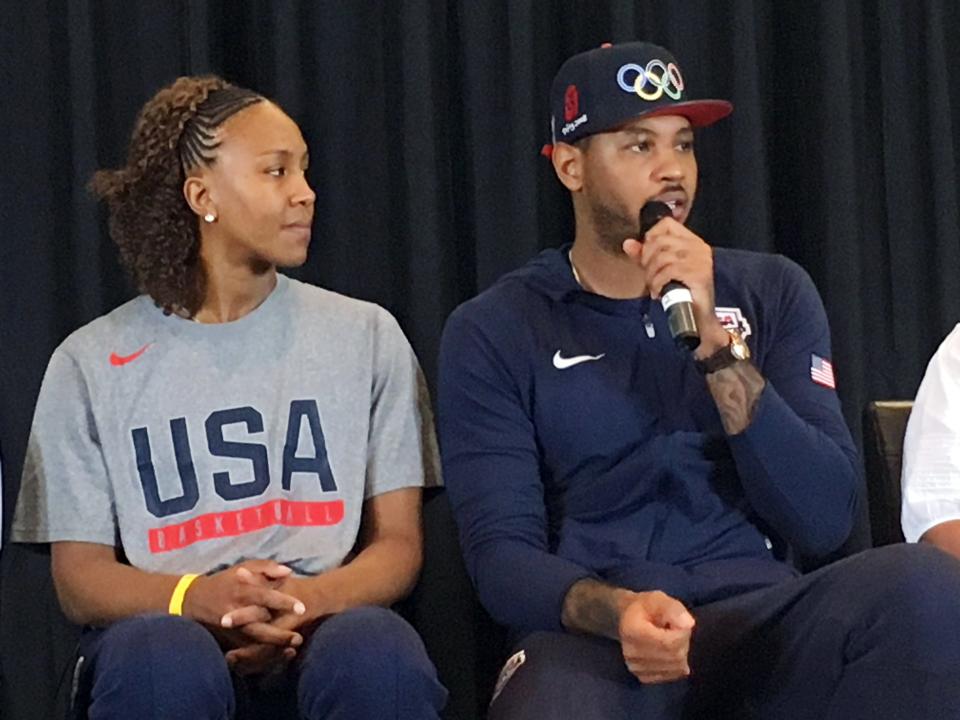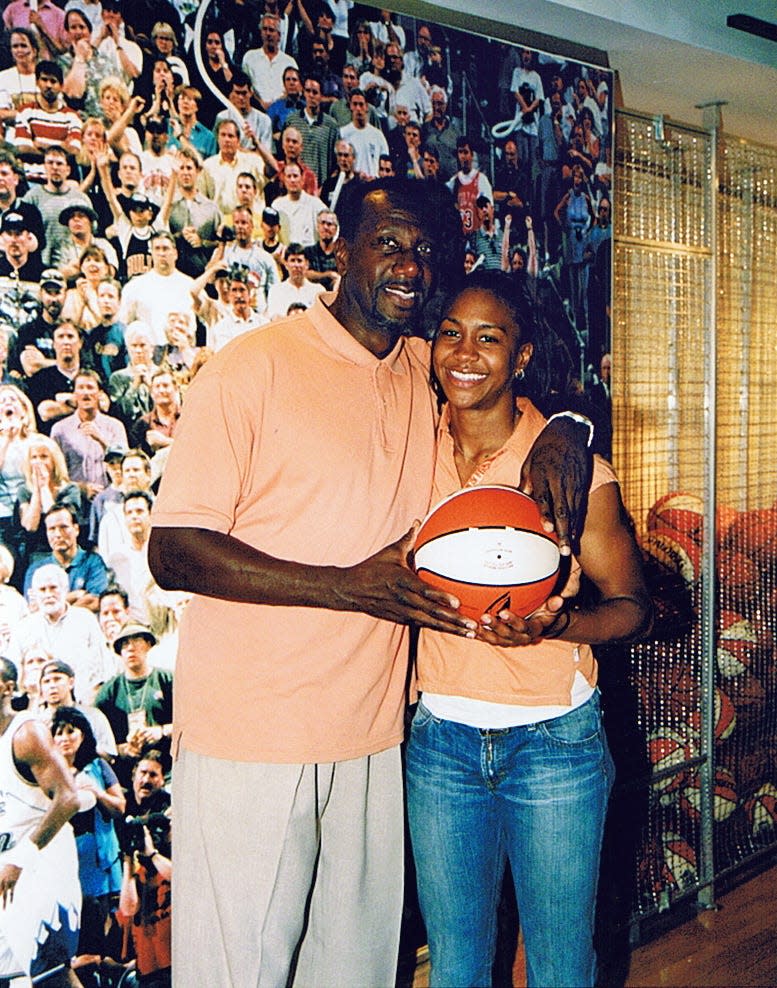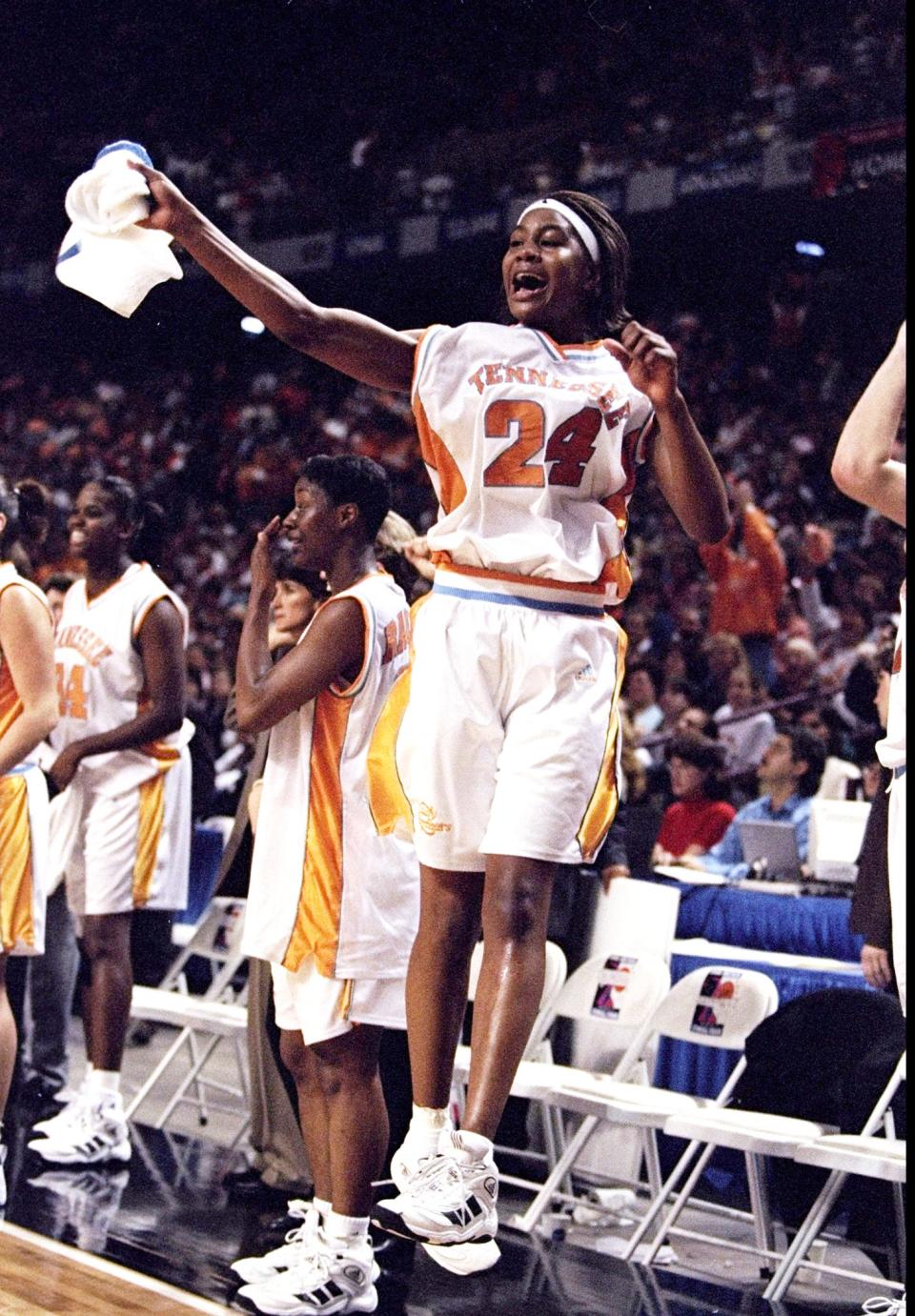Picture perfect career: Hall of Fame only part of Tamika Catchings' journey
Once she steps on stage, Tamika Catchings has numerous options on how to focus her speech.
When she becomes enshrined into the Naismith Memorial Basketball Hall of Fame as part of the 2020 class on Saturday, Catchings could simply list her resume that included being one of 14 women’s basketball players to win a championship both in the NCAA and the WNBA. Or perhaps she could detail how she overcame a hearing disability as a young child before having successful stints at the University of Tennessee (1997-2001), with the Indiana Fever (2002-2016) and on the gold medal-winning U.S. Olympic teams (2004, 2008, 2012, 2016).
It seems inevitable she will detail part of that journey. But expect Catchings to devote a significant part of her speech on her work with the “Catch the Stars Foundation.” She has overseen that with her sister (Tauja) since 2004 to help local youth with basketball camps, fitness clinics, college scholarships and mentorship programs.
“What am I most proud of as far as being a professional athlete and being in the WNBA? It’s the foundation,” Catchings told USA TODAY Sports. “It’s great to be able to have all of the individual accomplishments and team accomplishments. But in five to 10 years, people won’t even remember any of that. It’s about the people you impact along the way.”

That impact has become tangible in various ways.
According to Catchings’ foundation, it has served about 2,500 youth with $48,000 worth of renewable scholarships and 1,100 donated backpacks every year. Since 2011, the foundation also partnered with the University of Tennessee’s School of Education & Health and Human services to assist at-risk high school students in Knoxville, Tenn.
Even before the foundation’s launch, Catchings spent just as much energy establishing roots in Indiana’s community as she did on the hardwood.
The Fever selected Catchings with the No. 3 pick in the 2001 WNBA Draft despite nursing an ACL injury during her senior year with the Lady Vols. So, Catchings used her time in between rehab into creating relationships with the Indianapolis community. She hosted clinics at the Riverside Park and Family Center before soon expanding into a basketball camp and launching her foundation.
Catchings then became the WNBA’s players union president (2003-2016) where she pushed for greater pay and became part of the league's early efforts with speaking out on systemic racism. Shortly after her retirement from the WNBA, Catchings purchased Tea’s Me Café in 2017 both to expand the boutique tea store, host virtual discussions about social-justice issues and partner with grassroots organizations. In her current role as the Fever’s vice president of basketball operations and general manager, Catchings also helped oversee the franchise’s efforts with using Bankers Life Fieldhouse as a voting site for the presidential election.
“I don’t think there is a player over their career that has given more than ‘Catch’ has to Indiana,” South Carolina women’s basketball coach and former WNBA player Dawn Staley told USA TODAY Sports. “Hall-of-Famers are ones that get in more than likely for what they’ve done in between the lines. But her profile is so much more than that.”
Catchings ‘at the top of the heap’
Still, Catchings has also cemented an extensive profile for what she accomplished in between those lines.
She remains the WNBA’s third-leading scorer (7,380 points) and rebounder (3,315) as well as the league’s all-time leader in steals (1,074) and second-leading all-time leader in free throws (2,004). Catchings has also logged WNBA records in post-season play for most points (1,141), rebounds (598), free throws (356), steals (152), double-doubles (27), minutes (2,310) and games (68).
Catchings fulfilled that job description while leading the Fever to an WNBA record 12 consecutive playoff appearances (2005-2016), making multiple All-Star teams (10) and All-WNBA First Teams (seven) and collecting trophies as a Finals champion (2012), Finals MVP (2012) and regular-season MVP (2011). In between those WNBA seasons, Catchings also became one of five women’s basketball players to win four Olympic gold medals, including Lisa Leslie, Diana Taurasi, Sue Bird and Teresa Edwards.
No wonder Naismith Memorial Basketball Hall of Fame President John L. Doleva ranked Catchings “at the top of the heap” among women’s basketball players. To capture how she reached that level, Catchings chose former NBA player Alonzo Mourning as her presenter because he embodied how she aspired to play.
“He could do everything,” Catchings said. “He did whatever his team asked of him. I always wanted to be a player that could do anything that my team asked of me.”
Using hearing impairment as a superpower
Catchings developed that mentality partly because she was diagnosed with a hearing disability at age three. At first, Catchings said she felt insecure about her disability and “wanted to fit in and be like everybody else.” At varying times through her life, Catchings added she has experimented playing with and without wearing hearing aids.
“Having a hearing impairment has definitely been my superpower,” Catchings said. “It has given me strength, and it has sharpened some of my other skills. It sharpened some of my other senses on the basketball court to be able to see things happen before they happen.”
Catchings also learned from her father, Harvey, following a 12-year NBA career. When Harvey played one season overseas in Italy (1986-87), Catchings also met a young Kobe Bryant who will be among this year’s Hall-of-Fame class and also had a dad that played professionally in Italy. Catchings discovered that her work ethic could offset her hearing deficiency.

That mindset helped her become the first basketball player at any level to record a quintuple-double (25 points, 18 rebounds, 11 assists, 10 steals and 10 blocks) when she starred at Duncanville High School in Duncanville, TX. It also played a role in Catchings leading the Lady Vols to an undefeated championship season during her freshman year (1998), winning the Naismith College Player of the Year award (2000) and earning four All-American first team honors (1998-2001).
“There wasn’t a day where there wasn’t blood on the floor with how hard we went,” Catchings said. “We battled every day. By the time we got to the games, sometimes the games were easier than practice just because of how hard we worked each other.”
Catchings kept that same mentality when she entered the WNBA. While missing her initial season because of her ACL injury, Catchings said she rehabbed and eventually trained with the Fever’s coaching staff “every single day.” She largely credited that preparation both with healing her injury and winning the WNBA’s rookie of the year award the following season.
Still, Catchings said she felt she had plenty to prove. During tryouts for the 2002 World Championships, Catchings heard that coach Van Chancellor told others “that’s she’s not good enough to play at this level.” Upon hearing that, Catchings vowed to prove otherwise hoping that her on-court hustle would silence the skepticism.
“I went diving for the ball from behind,” Catchings said. “He turned around and saw me and said, ‘That’s why she’s here!’”
Therefore, Catchings earned a spot on the 2004 U.S. Women’s Olympic team. Then Staley expressed appreciation to Catchings both for her talent and work ethic, while encouraging her to become a better vocal leader instead of just hoping her actions would speak for themselves.
“She’s my all-time favorite WNBA player,” Staley said. “There aren’t many of them that will sacrifice. She sacrifices a good time in order for her to be the best that she can be. She was that. You could see that very early on.”
That is partly because Catchings listened intently to Staley, whom Catchngs likened for being “a director of an orchestra” for how she managed both young and veteran teammates.
“That’s not to say I immediately became this great leader,” Catchings said. “I’m always in a position to learn and get better. But she was definitely the one that planted the seed for me as a player and what I was capable of doing for my teammates in Indiana.”

Part of that role entailed remaining patiently persistent with the Fever’s direction. Despite the franchise’s consistent playoff appearances, the Fever lost once in the WNBA Finals (2009), three times in the Eastern Conference Finals (2005, 2007, 2011) and four times in the first round (2002, 2006, 2008, 2010) before winning the league title (2012).
Now in a front-office role, Catchings has just as high expectations for the Fever despite missing the playoffs for the past four years following her retirement.
“I want us to win in three years, at most. If we win this year, I’ll take that as well,” Catchings said.
Accomplishing benchmarks off the court
Catchings has also kept her focus on her off-the-court endeavors.
Interestingly, Catchings only accepted the role as president of the WNBA players union after other players chose her. But she said she pushed for initiatives that the WNBA and the players union eventually agreed upon last year in an eight-year deal, including a nearly triple salary increase, full maternity leave benefits and an increased split in league revenue should it reach certain benchmarks.
In 2016, the Fever, Lynx, Phoenix Mercury and New York Liberty wore T-Shirts over their warmups with “Black Lives Matter” slogans in response to police killing or shooting unarmed Black people. The league fined all teams $5,000 and all players $500 before quickly rescinding the punishments.
“Maybe people misunderstood it then. But as we moved on, people have understood what the fight has been about,” Catchings said. “It’s not just about doing something. It’s about the actions that follow. We’re in it for the long haul.”
Therefore, Catchings became receptive to how the WNBA’s players vowed to speak out on systemic racism in the ‘Wubble’ during the 2020 season in Florida. Catchings also credited Candice Dupree for suggesting in a meeting that the Fever could use Bankers Life Fieldhouse as a voting site. That eventually became a reality.
“You listen to what they want and you listen to their voices,” Catchings said. “They like that you listen and put it into action. There were a lot of steps that was taken to have that as a voting site.”
In her Hall-of-Fame speech, expect Catchings to detail those steps as well as the numerous ones she took to become more proud of what she accomplished in the community over what she accomplished on the court.
Follow USA TODAY NBA writer Mark Medina on Twitter, Facebook and Instagram.
This article originally appeared on USA TODAY: Tamika Catchings' Hall of Fame induction is small part of journey

